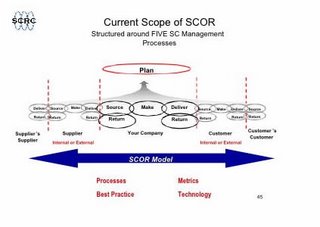
Formed in collaboration with 69 members consisting of manufacturers, logistics / distribution service providers and software solutions suppliers, Supply Chain Council introduced Supply Chain Operations Reference-model (SCOR). Numbers of companies have pooled their real-world supply chain experiences to build a flexible framework and a common language that can help companies improve their supply chain internally and externally. The model defines common supply chain management process, matches them against “best practices”. It provides companies with powerful tool in improving supply chain operations. It allows manufacturers, suppliers, distributors and retailers with a framework to evaluate the effectiveness of their supply chain operations and to target and measure specific process operations.
The SCOR model was designed to enable companies to communicate, compare and learn from competitors and companies both within and outside of their industry. It not only measures supply chain performance but also effectiveness of supply chain reengineering. Further it has the ability to test and plan future process improvements. The SCOR is a process reference model. At the core of this model is a “pyramid of four levels” that represents the path a company takes on the road to supply-chain improvement:
Level 1: Provides definition of the Plan, Source, Make, and Deliver process types. This is the point where a company establishes its supply-chain competitive objectives
The basic structure of the reference-model focuses on the four key supply-chain processes: Plan, Source, Make, Deliver.
Level 1: Provides definition of the Plan, Source, Make, and Deliver process types. This is the point where a company establishes its supply-chain competitive objectives
The basic structure of the reference-model focuses on the four key supply-chain processes: Plan, Source, Make, Deliver.
Plan: Under this process the company should assess supply resources, aggregate and prioritize demand requirements, plan inventory, distribution requirements, production, material and rough-cut capacity of all products and all channels. Make/buy decisions are evaluated under this heading. Decision related to long term capacity and resource planning, product phase in / phase out are undertaken in this phase.
Source: Under this process sourcing infrastructure is managed. Various activities like vendor certification and feedback, sourcing quality monitoring, vendor contracts are conducted. Also activities involved with receiving of material like: obtain, receive, inspect, hold and issue material are under taken here.
Make: This process is concerned with production, execution and managing “make” infrastructure. Specifically under production execution activities like manufacturing, testing, packaging, holding and releasing of product are undertaken here. Under managing “ make” infrastructure, engineering changes, facilities and equipment management, production status, production quality, shop scheduling/sequencing and short-term capacity are planned and managed.
Deliver: This process consists of order management, warehouse management and transportation management. Under order management activities like maintaining and entering orders, generating quotations, configuring product are undertaken. Further create and maintain customer database, maintain product and price database, managing receivables and credit management also fall under this domain.
Warehouse management: Activities like pick up, package, creating customer specific packaging/labeling and shipment of products fall under the gamut of warehouse management.
Transportation and delivery infrastructure management: Under transportation management, activities like traffic management, freight management are undertaken. Delivery infrastructure encompasses of channel management rules, order management rules and managing delivery inventories and managing delivery quality.
Level 2: Level 2 defines 26 core process categories that are possible components of a supply chain. Organizations can configure their ideal or actual operations using these processes.
Level 3: Level 3 provides the information required for successfully planning and setting goals for supply-chain improvements. This includes defining process element, setting target benchmarks, defining best practices, and system software capabilities to enable best practices.
Level 4: Level 4 focuses on implementation, i.e. putting specific supply-chain improvements into action. These are not defined within industry standard model, as implementation can be unique to each company
Please refer to http://www.supply-chain.org/for more information on this model. For overview of SCOR go to the section called "Resources" on the left-hand menu to click on link called "SCOR overview".
Please refer to http://www.supply-chain.org/for more information on this model. For overview of SCOR go to the section called "Resources" on the left-hand menu to click on link called "SCOR overview".
Process Reference Model: Process reference model integrate the concepts of business process reengineering, benchmarking, and process measurement into a cross-functional framework. A Process Reference Model helps organizations capture the "as-is" state of a process with the objective to achieve the desired "to-be" future state. Further it allows organization to quantify the operational performance, establish internal targets based on "best-in-class" results in similar companies. It describes standard management processes, exploring relationship among different processes. It defines standard metrics to measure process performance and management practices that produce the best-in-class performance. Finally it characterize the management practices and software solutions that result in "best-in-class" performance
Process reference helps complex management process be captured in standard process reference model. This in turn help organization communicate unambiguously and measure, manage, tune and re-tune specific process
Process reference helps complex management process be captured in standard process reference model. This in turn help organization communicate unambiguously and measure, manage, tune and re-tune specific process
No comments:
Post a Comment